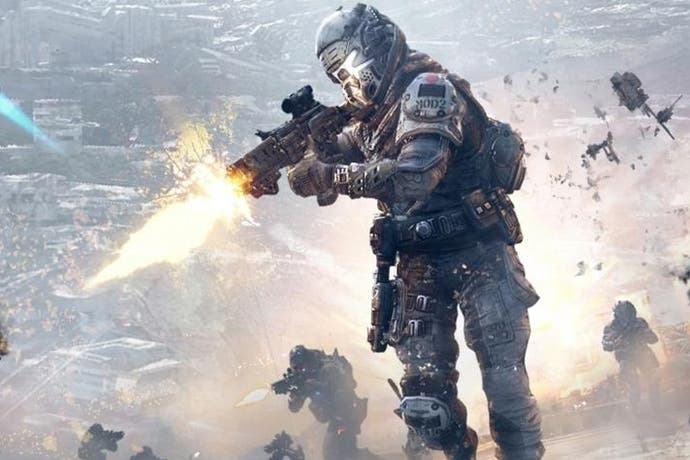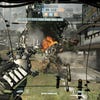Tech Analysis: Titanfall beta on Xbox One and PC
An in-depth look at Respawn's riotous new shooter, with performance analysis.
In our earlier exchange with Titanfall developer Respawn, the words "frame-rate is king" rang loud as its mission statement. Perhaps it's not too surprising, then, that visually the game is a composite of striking and bland elements - a vibrant effects-fest in motion, but with a clinical simplicity elsewhere that can be hard to overlook. We've seen these cutbacks before, of course, and if there's one thing that can get you off the hook for taking this approach, it's a low-latency 60fps golden standard. In the case of the Titanfall beta, however, the results aren't entirely as expected.
Before we get stuck into the tests, we have to put the current state of the game into perspective. This is a beta build, and one which we were told by staff at a recent preview event is the most stable the team had to hand for show, rather than necessarily its most up-to-date code. Other adjustments are promised to be in the works, though how greatly they'll remould the game from its current form remains to be seen.
What we can confirm for this build, though, is an internal resolution of 1408x792, with a pass of 2x MSAA to tackle aliasing before any upscale to your preferred resolution. This pixel count is something the team is happy to verify - even with indications that it could end up around the 900p mark for the final product. It may not be a gargantuan number as-is, but it pulls the game away from the ho-hum 1280x720 that was on most peoples' bingo cards - a step up, if not a remarkable one, in terms of the final image.
"What we can confirm for this build is an internal resolution of 1408x792, with a pass of 2x MSAA before any upscale to your preferred resolution."
Still, in a generation where fists are being banged on tables for full 1080p, this does seem like a compromise - and one that speaks to the team's determination to hit 60fps first and foremost. By and large, Titanfall is a healthy 60fps shooter as promised, but only as long as it's played with an on-foot Call of Duty mindset. With Portal 2's Source engine at its core, it's as fluid and responsive as you could hope for when pistolling Pilots and kicking AI grunts.
However, it all changes once you buckle into a Titan, and in this build we see lengthy passages of play (particularly by the end of a mission) falling within the 35-45fps range. Neither one of the levels on show is especially worse than the other in this regard, and it's clearly the barrage of alpha effects that ends up pressing the hardware too far.
It's also impossible to ignore the tearing that creeps up during such dips. Adaptive v-sync is in play, which taps in any time the engine detects a frame going over budget and missing a slot within its 60Hz refresh. Temporarily removing this lock helps to make control over the action feel smoother than it otherwise would, but at a big - and regular - cost to the overall presentation. As a game with a heavy focus on competitive multiplayer, these are clearly optimisation problems that need tackling before the game goes to market in March - with screen-tear high on the list.
"In its current form, the reasoning behind Titanfall's resolution choice becomes uncertain when considering the variable returns on performance."
In its current form, it's difficult to understand Titanfall's resolution choice considering the variable performance. As it renders at 792p, The game relies on the Xbox One's scaler to output at 1080p. Now, we've just updated our Xbox One to the latest system software and the good news is that the harsh edge-enhancement has completely gone. We'll be looking at the improved scaler in a little more depth very soon, but while the situation is clearly an improvement on the preview code we saw previously, there's still a good deal of aliasing to contend with. It appears that Respawn is caught between a rock and a hard place with regards image quality vs. performance.
Frame-rate hit or not, trundling forward in a Titan still kicks off the most spectacular moments possible in the game. The animation for loading into a cockpit is a show-stopper, and details like having each window pane rendered individually before meeting in the centre are complex touches that surprisingly don't stretch the frame-rate. Certainly, most alpha effects from missiles look plain in isolation, but in their numbers, and in concert with lengthy smoke trails and spark particles, you can convincingly create a maelstrom of elements that still looks impressive.
That said, it's unfortunate that once you stop to have a look around at the arena that the environment appears so clinical. Much of Fracture, for example, is built to a very strict and rigid wireframe, with no evidence of next-gen technologies such as tessellation to round off the more egregious corners. Shading is also largely missing, outside of baked-in shadows and ambient occlusion that fades in we near objects. The two maps shown so far are vibrant and well-suited for the wall-run-and-gunning gameplay, but without these extra layers of detail the whole world come across as a little plain, lacking in dynamic destruction and enhanced environmental detail and animation. It's clear where the emphasis is: Titanfall relies upon the sheer intensity of its action for its measure of spectacle.
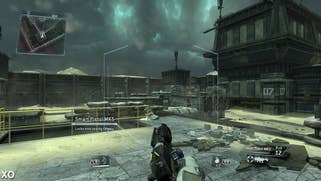
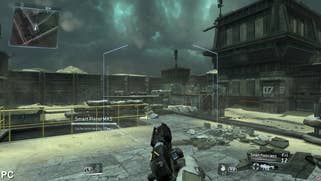

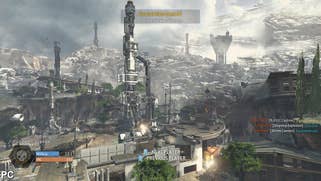
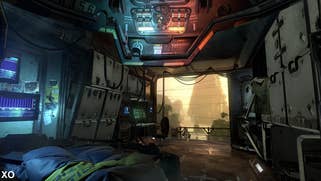

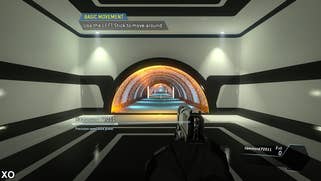
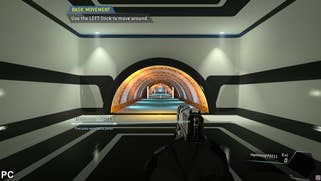
These are issues that aren't solved by the PC route, even on maxed settings. Right down to the geometry LOD pop-in, many of the Xbox One version's foibles are still present on relatively unbounded hardware. Making a quick dart forward makes it very easy to catch pop-in across rocky formations and vegetation, even on PC, while physics-affected debris on the floor fades in metres away.
Fortunately, the PC version finds other ways to set itself apart. This is primarily by means of offering a full 1080p (or higher) image, up to 8x MSAA, plus a field-of-view slider that can be tweaked from 70 to 90. This at least nips in the bud all the issues that are currently hitting the Xbox One version, though the admitted lack of mod support for the game means custom tweaks will be trickier to add.
Visually, PC gamers looking for an edge over the console release in terms of lighting, shadows, effects or model detail may be disappointed. Even at the "insane" texture quality setting on PC, the oil rig structures around the Fracture map still share precisely the same washed-out mapping as the Xbox One, while floor mapping is also like-for-like. Much of the game's assets and rendering tech are shared in this sense, right down to the distance of the shadow filtering cascade.
"With recent suggestions of resolution being pushed up higher to the 1600x900 mark, it's not clear where the GPU power can be found to maintain a large boost in overall pixel count."
The other area we'd expect the PC beta to show its strengths is in performance. Taken on by an Intel i7-3770K PC clocked at 4.3GHz, with 16GB RAM and a relatively modest Radeon HD 7850 GPU with just 1GB of GDDR5, we manage to max the game out almost entirely while holding 60fps at 2x MSAA. The snag is in the shadow quality settings, where holding on to the highest option causes hiccups down to 40fps - easily solved by dropping it a notch, with little if anything noticeable in the way of a quality hit. Given that the card is flexible enough to even handle 2x MSAA at this resolution, the beta build appears to not place too great a demand on the GPU side. Indeed, upping to 4x MSAA still produces a good experience, with frame-rates in the 55-60fps area with v-sync engaged (both double and triple-buffering are supported).
Although based on the Source engine, it's clear that a lot of work has gone into improving the tech - it's now DirectX 11 based, it utilises up to six CPU cores, but despite that, it's hardly a processing heavyweight: while we deployed the i7, further tests reveal that even a lowly AMD FX-6300 or Core i3 is capable of providing solid 60fps gameplay. In short, the Titanfall beta suggests a well-balanced game that should hold its own across a wide range of hardware - and once again we see £100 GPUs besting the console experience.
All of which leads us back to the assessment of the Xbox One version's fate. Titanfall is only a month shy of its final March release, and the tussle in this early beta is clearly between performance and effects-work. Given Respawn's reputation in the business, we'd hope frame-rate does indeed prove to be king. However, with recent suggestions of the internal resolution being pushed up higher to the 1600x900 mark, it's not clear where the GPU power can be found to maintain a large boost in pixel count while at the same time clearing up the frame-rate issues we find in the current 1408x792 version.
However, while the Xbox One beta has its own fair share technical quibbles, there is an undeniable entertainment factor to the game that takes precedence. It's a simple package, but the commitment to 60fps so far is strong enough to convince that the right talents are working on the project. In the meantime, while we have a firm handle on the Xbox One and PC versions of the game, we can't help but wonder how the Xbox 360 version will compare.
